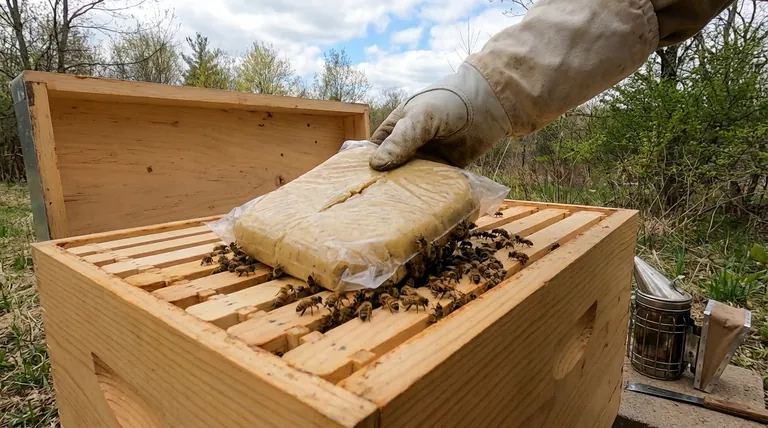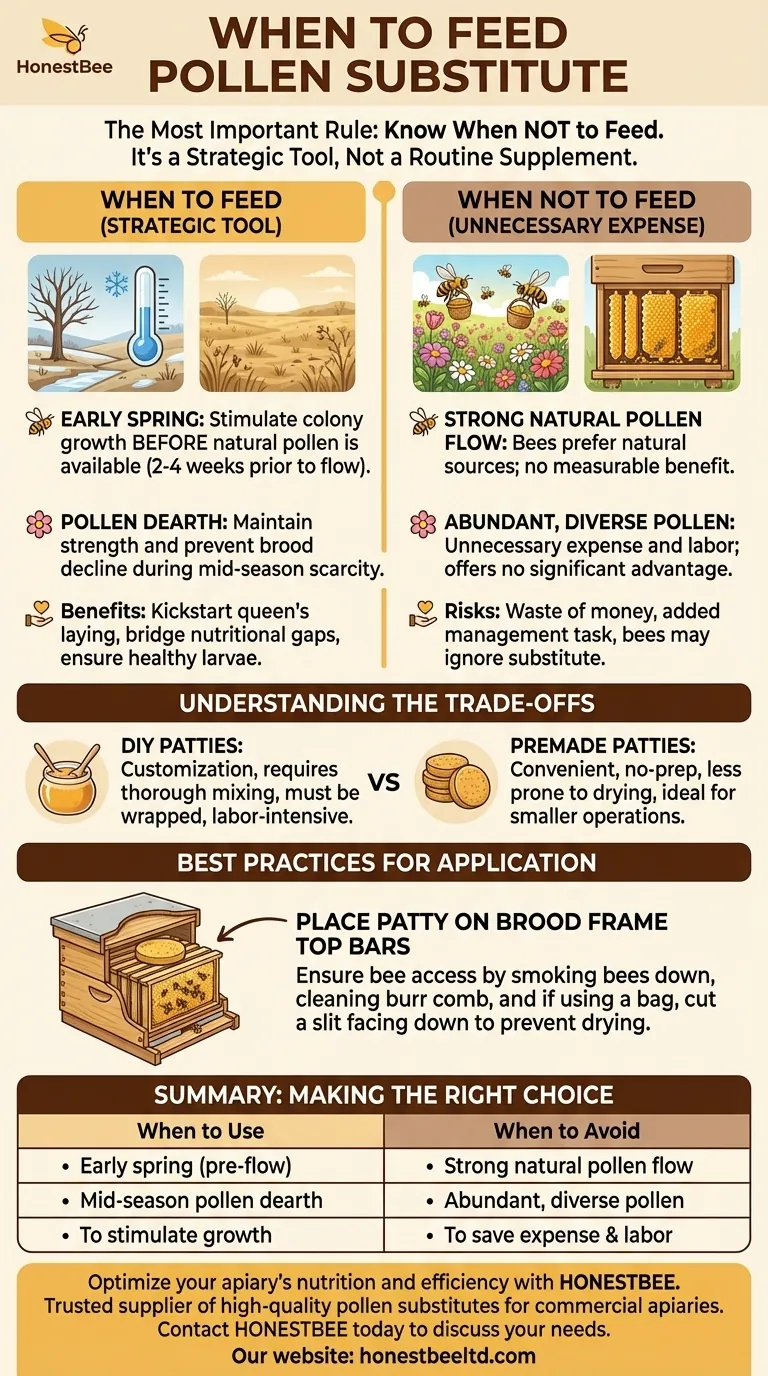The most important practical application is knowing when not to feed pollen substitute. If your bees have access to adequate, high-quality natural pollen, there is no apparent benefit to providing a substitute. Feeding it in these conditions is an unnecessary expense and offers no significant advantage to the colony.
Pollen substitute is a strategic tool for bridging nutritional gaps, not a routine supplement. Its primary value is in stimulating colony growth when natural pollen is scarce, such as in early spring or during a pollen dearth.

The Role of Protein in a Honeybee Colony
Why Protein is Essential
Honeybees require protein to thrive. This essential nutrient, derived from pollen, fuels the queen's egg production and enables worker bees to produce the brood food necessary for raising healthy larvae.
Protein is the engine of colony growth. Without it, the colony cannot effectively transition from its winter cluster into the active, expanding phase of spring and summer.
Natural Pollen: The Gold Standard
Natural pollen is the ideal source of protein and other micronutrients for bees. A diverse range of natural pollen sources provides a complete nutritional profile that is difficult to replicate perfectly.
Pollen substitutes are engineered to provide the essential protein and amino acids bees need, acting as a replacement when natural sources are unavailable or of poor quality.
When to Feed Pollen Substitute (And When Not To)
The Critical "When": Bridging a Nutritional Gap
The most effective use of pollen substitute is to stimulate the colony before natural pollen is available. Feeding in late winter or early spring encourages the queen to begin laying, giving the colony a head start on building its population for the main nectar flow.
It is also valuable during a mid-season "pollen dearth," a period where no flowers are blooming, to prevent a decline in brood rearing and maintain colony strength.
The Critical "When Not": During a Pollen Flow
The key advice is to avoid feeding when bees are already bringing in abundant, diverse pollen. During a strong natural pollen flow, bees will often prefer the real thing.
Adding a substitute at this time provides no measurable benefit to colony health or growth and is therefore a waste of both money and the beekeeper's effort.
Understanding the Trade-offs
DIY vs. Premade Patties
Making your own pollen substitute allows for customization but requires careful work. The powder and sugar syrup must be thoroughly mixed into a soft paste. The mixture must be kept well-wrapped to prevent it from drying out, as bees cannot consume it if it becomes hard.
Premade patties are a convenient, no-preparation option that is less prone to mixing or drying issues. This makes them an excellent choice for beekeepers with a smaller number of hives who prioritize ease of use.
The Risk of Unnecessary Feeding
The primary trade-off of feeding pollen substitute when it isn't needed is financial. It is an expense that yields no return if the colony already has access to superior natural resources. It also adds an unnecessary management task to your apiary workflow.
Best Practices for Application
Proper Placement in the Hive
The most common method is to place the pollen patty directly inside the hive where the bees can easily access it in any weather.
The patty is typically placed directly on the top bars of the brood frames, just under the inner cover or crownboard. This puts the food source right next to the nurse bees who need it most.
Ensuring Bee Access
After smoking the bees down, clean the top bars of any burr comb. If using a substitute in a plastic bag, lay the bag on the frames and cut a slit across the side facing down.
This slit allows the bees to access the patty while the bag prevents it from drying out too quickly, ensuring it remains soft and palatable.
Making the Right Choice for Your Apiary
To determine if you should feed, assess your specific goals and local conditions.
- If your primary focus is kickstarting colony growth in early spring: Feed a pollen substitute 2-4 weeks before natural pollen becomes available in your area.
- If your primary focus is maintaining strength during a summer dearth: Provide a substitute to prevent a lapse in brood rearing when natural pollen is scarce.
- If your primary focus is efficiency and there is a strong natural pollen flow: Save your money and labor, as feeding a substitute will offer no significant advantage.
Ultimately, using a pollen substitute effectively depends on observing your bees and understanding their nutritional environment.
Summary Table:
| When to Use Pollen Substitute | When to Avoid It |
|---|---|
| Early spring before natural pollen is available | During a strong natural pollen flow |
| During a mid-season pollen dearth | When bees are bringing in abundant, diverse pollen |
| To stimulate colony growth for a nectar flow | To save on unnecessary expense and labor |
Optimize your apiary's nutrition and efficiency with HONESTBEE.
As a trusted supplier of beekeeping supplies and equipment to commercial apiaries and distributors, we provide the high-quality pollen substitutes and feeding solutions you need to manage colony growth strategically. Let our wholesale-focused operations support your success.
Contact HONESTBEE today to discuss your specific needs and strengthen your colonies.
Visual Guide

Related Products
- Slatted Porter Style Bee Escape for Rapid Hive Clearing
- Premium Traditional Copper Bee Smoker with Bellows
- Brown Nicot Queen Cell Cups for Breeding Queen Bees Beekeeping
- Professional Spring-Action Queen Catcher Clip
- Long Langstroth Style Horizontal Top Bar Hive for Wholesale
People Also Ask
- What was the result of using the bee escape board? Achieve a Calm, Low-Stress Honey Harvest
- What is the correct orientation for placing Triangular Escape Boards? Ensure a Stress-Free Honey Harvest
- How does the design of Triangular Escape Boards work? Achieve a Stress-Free Honey Harvest
- What is the purpose of Triangular Escape Boards? Achieve a Calm, Efficient Honey Harvest
- How long should a bee escape be placed before harvesting honey? The 24-48 Hour Guide to a Stress-Free Harvest



















